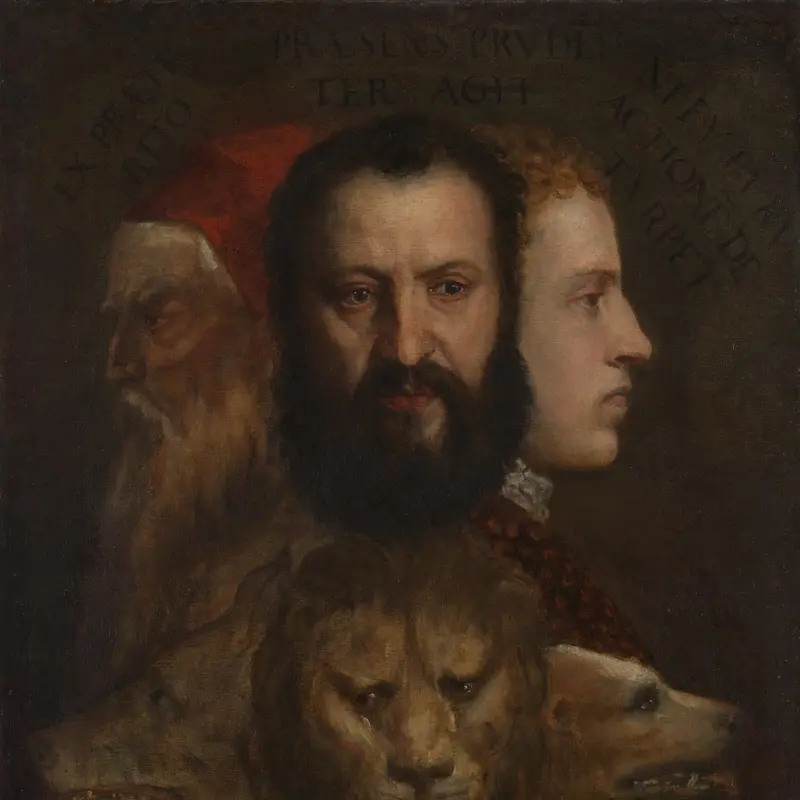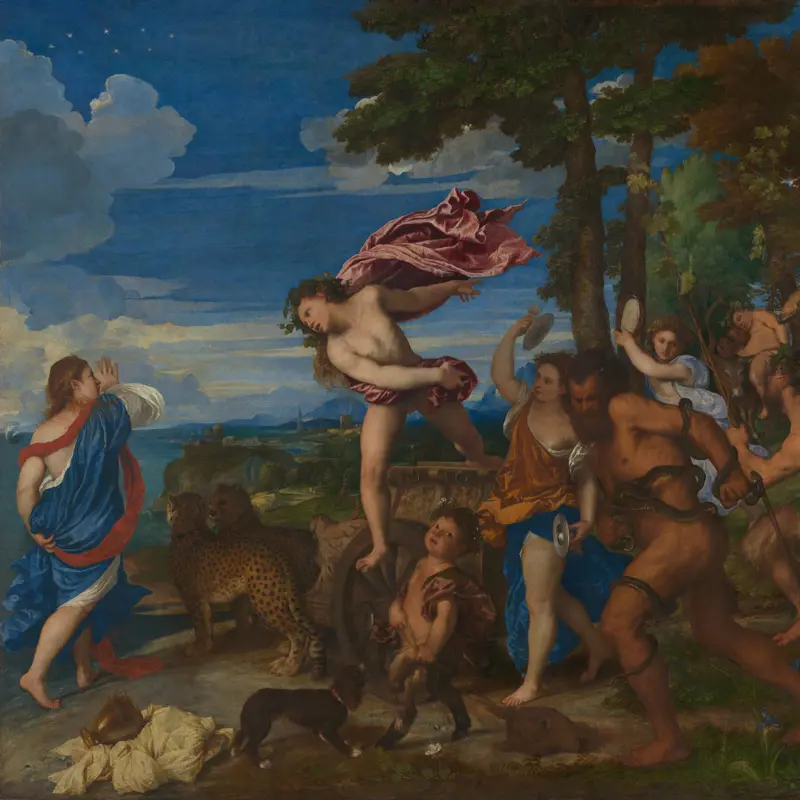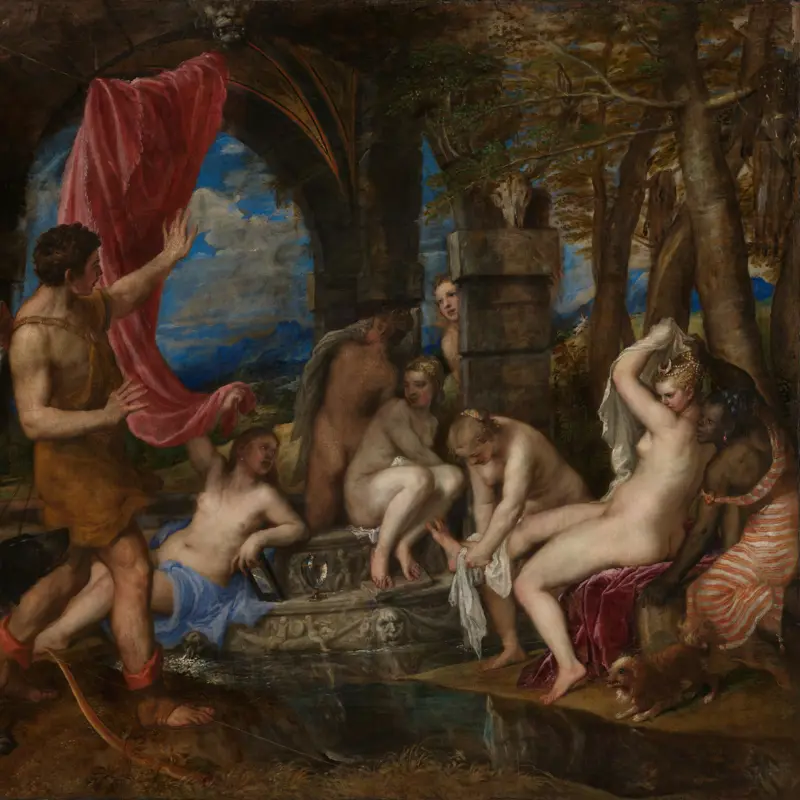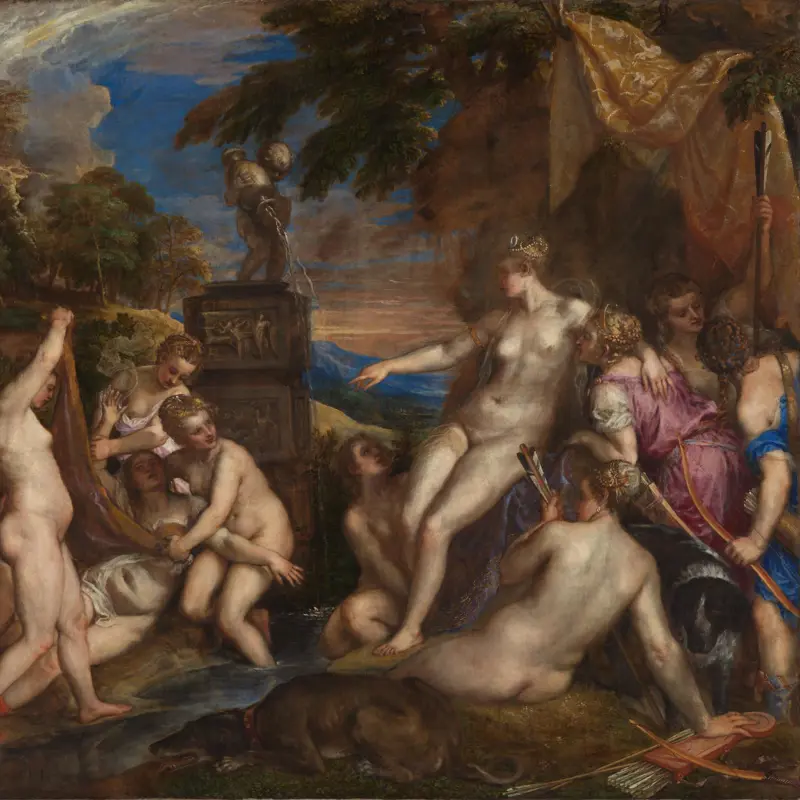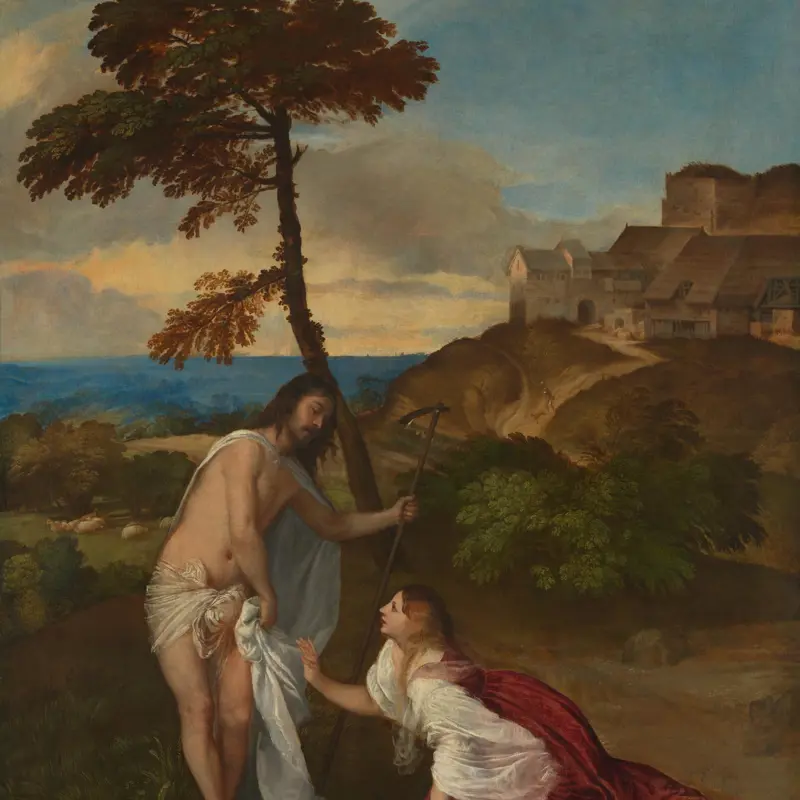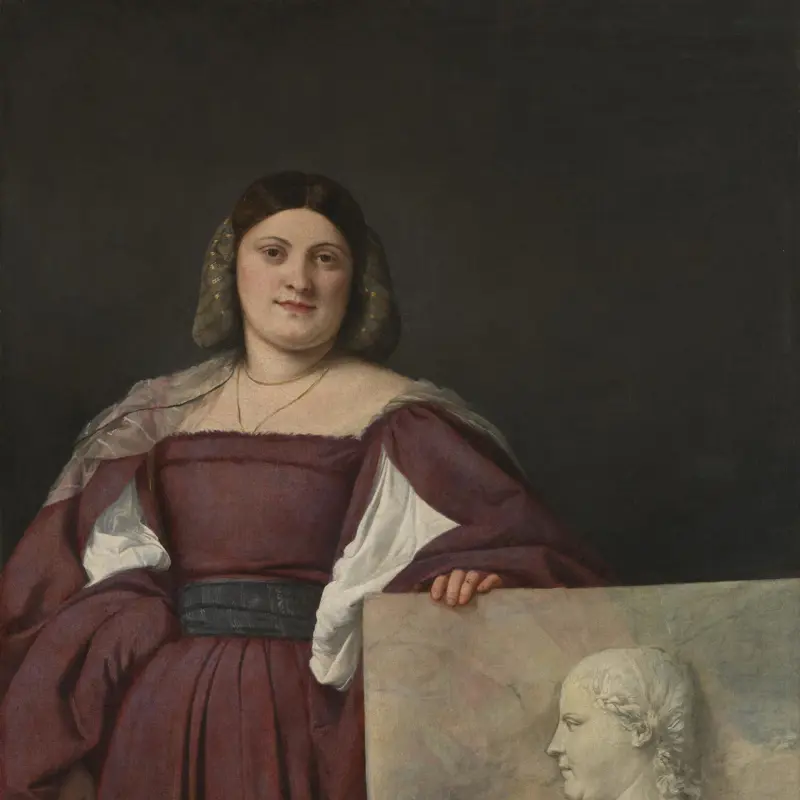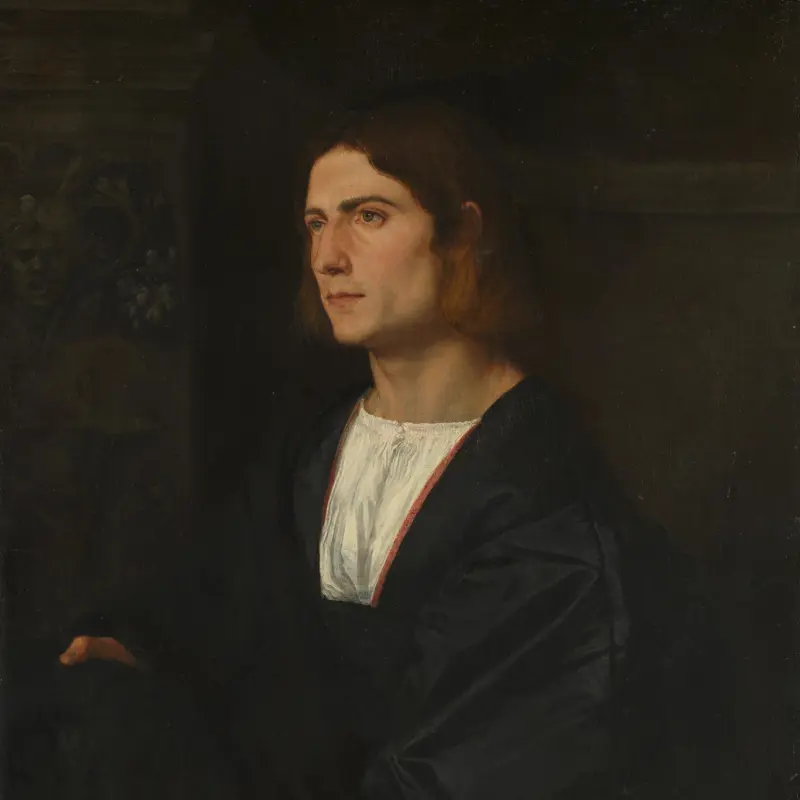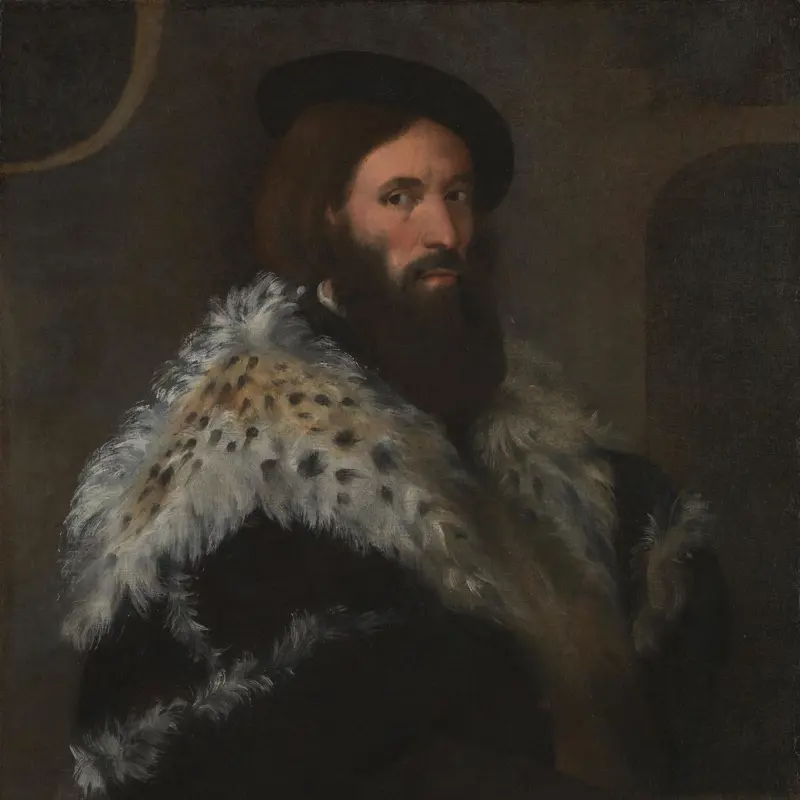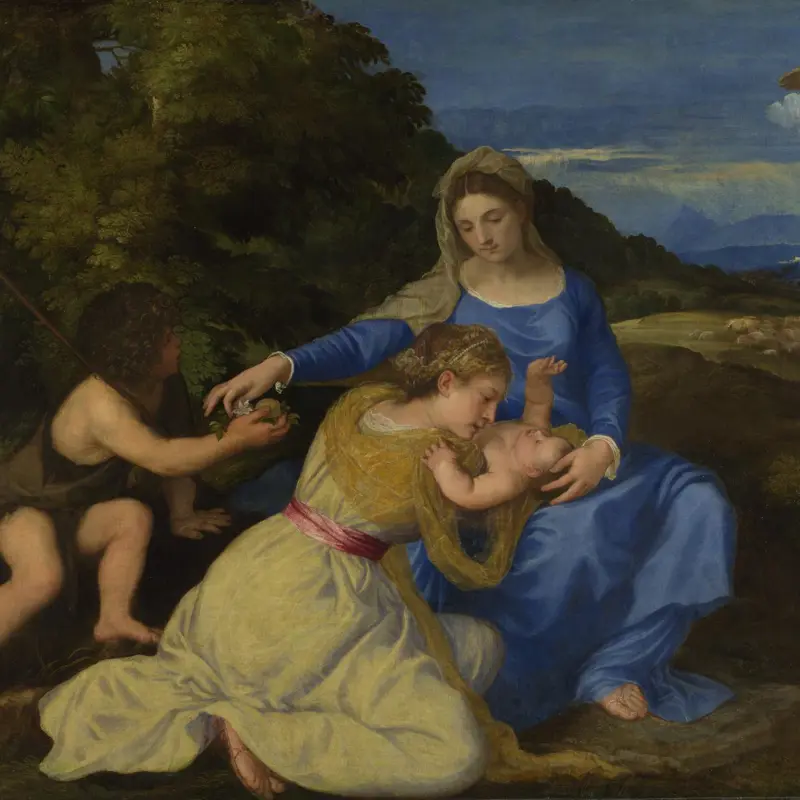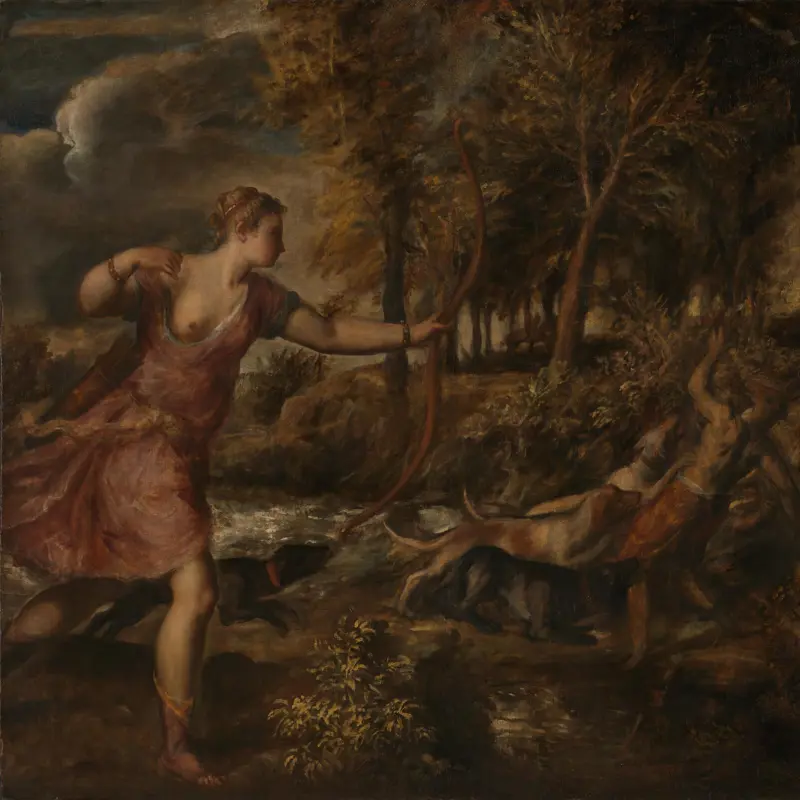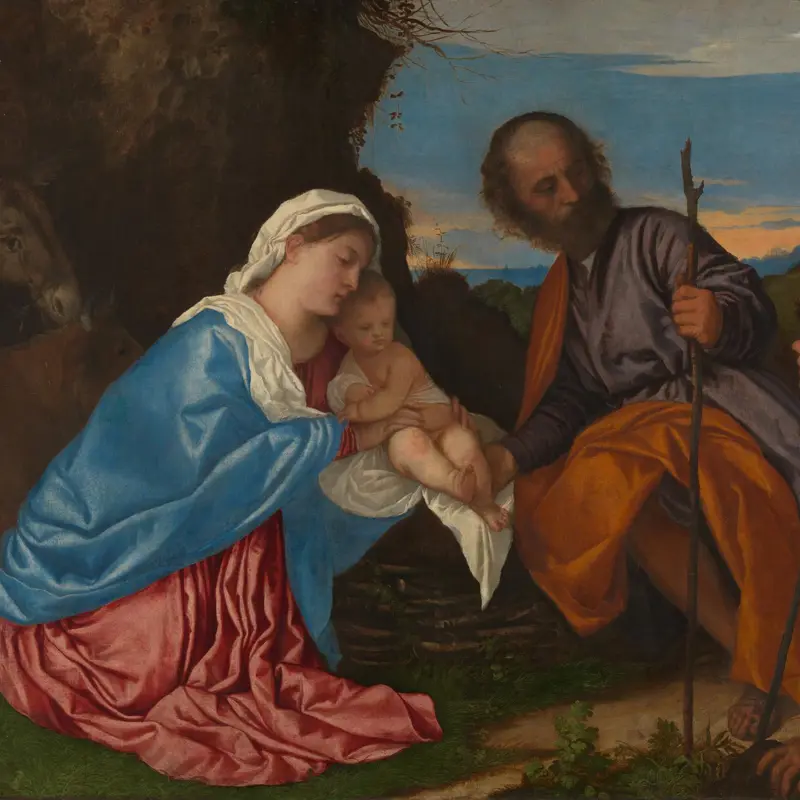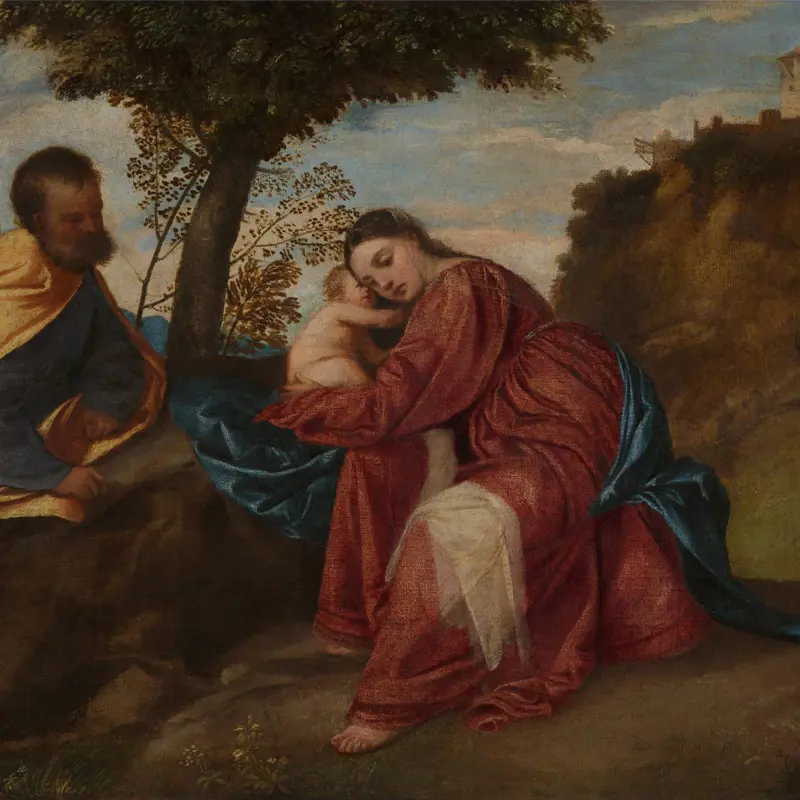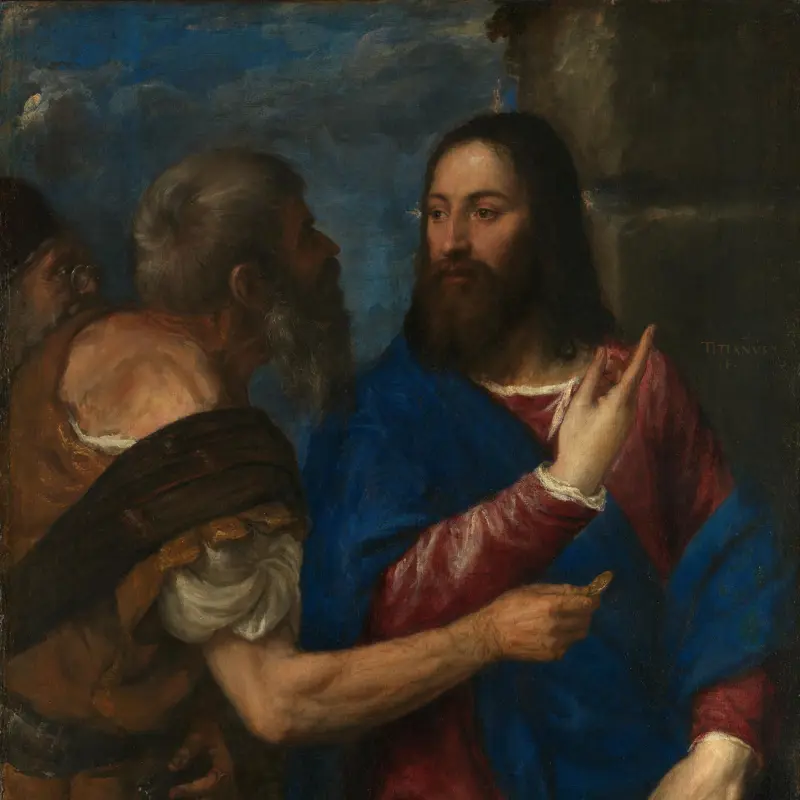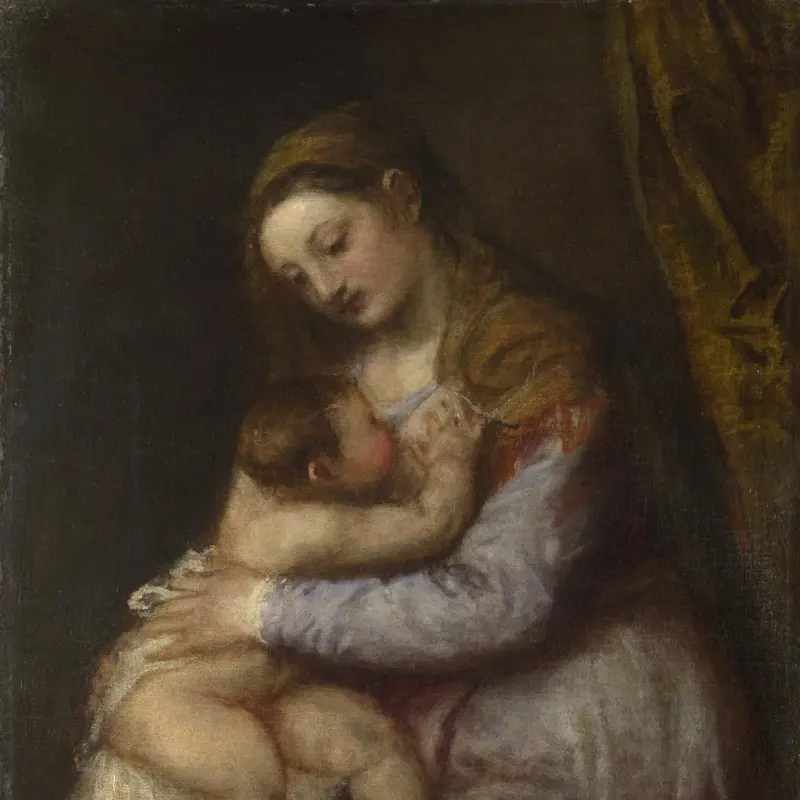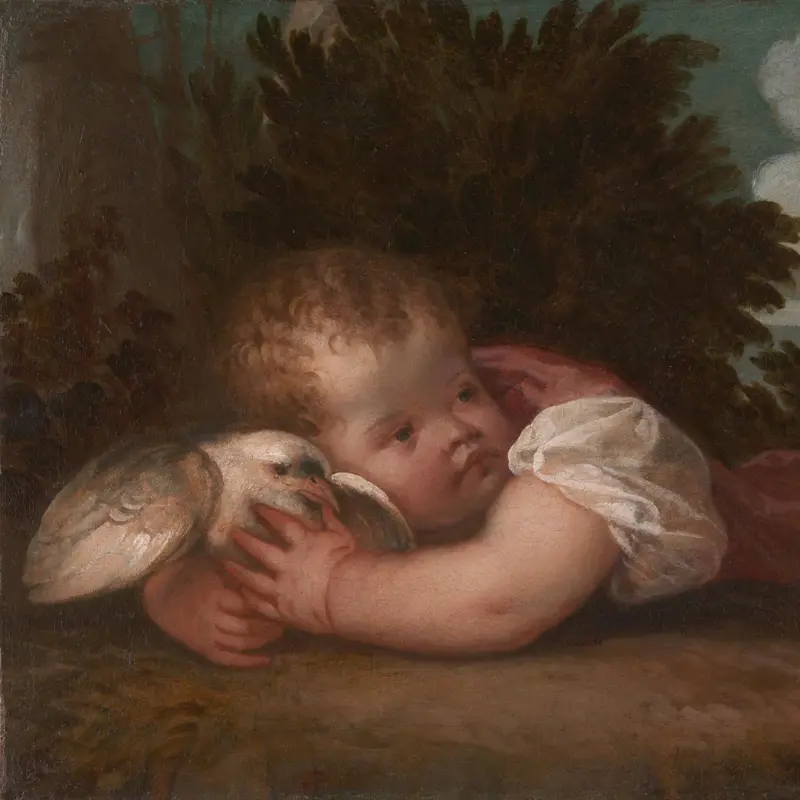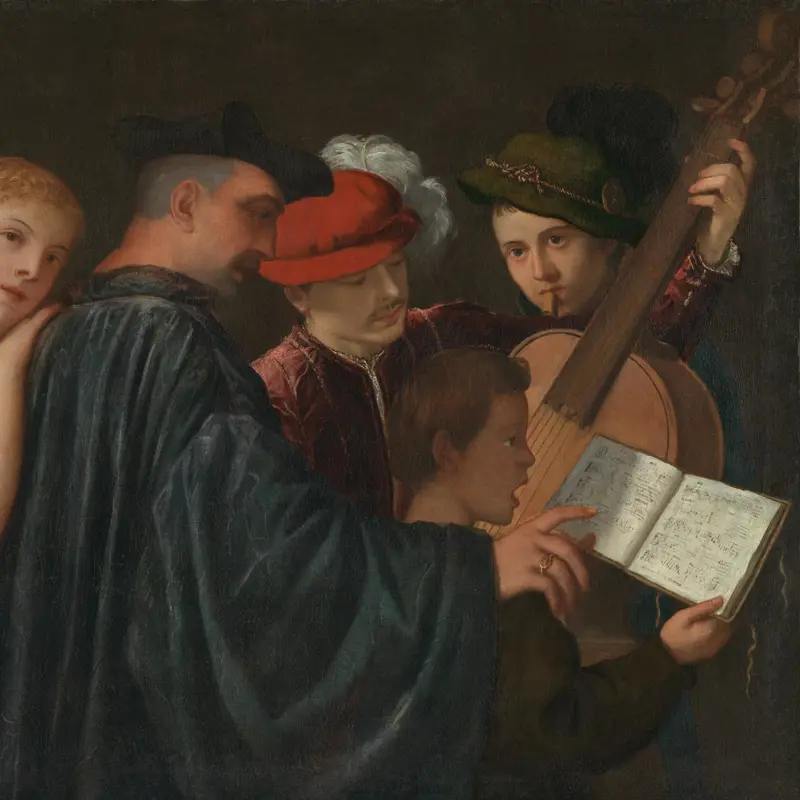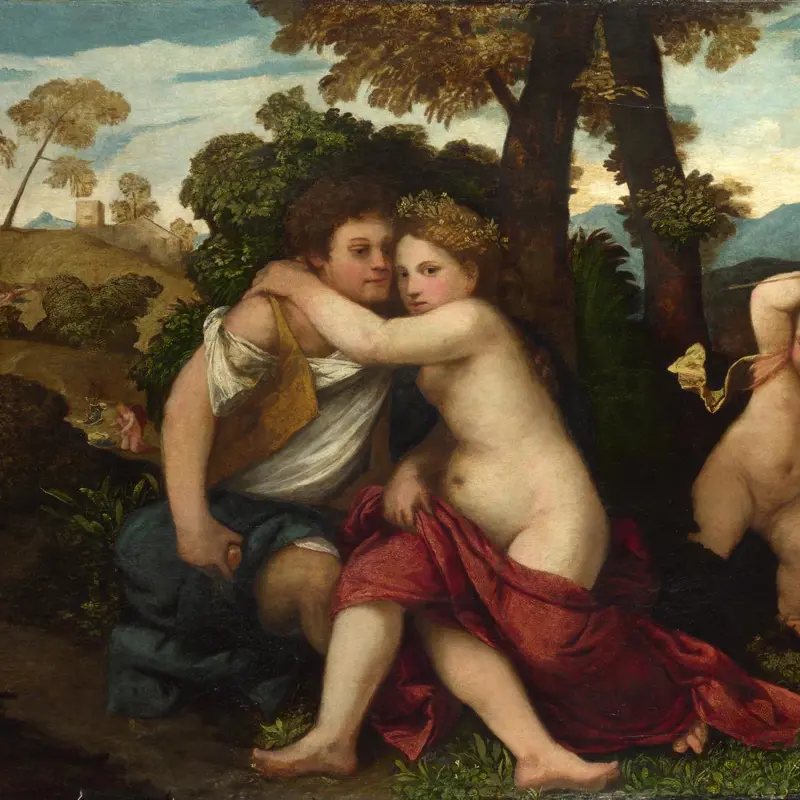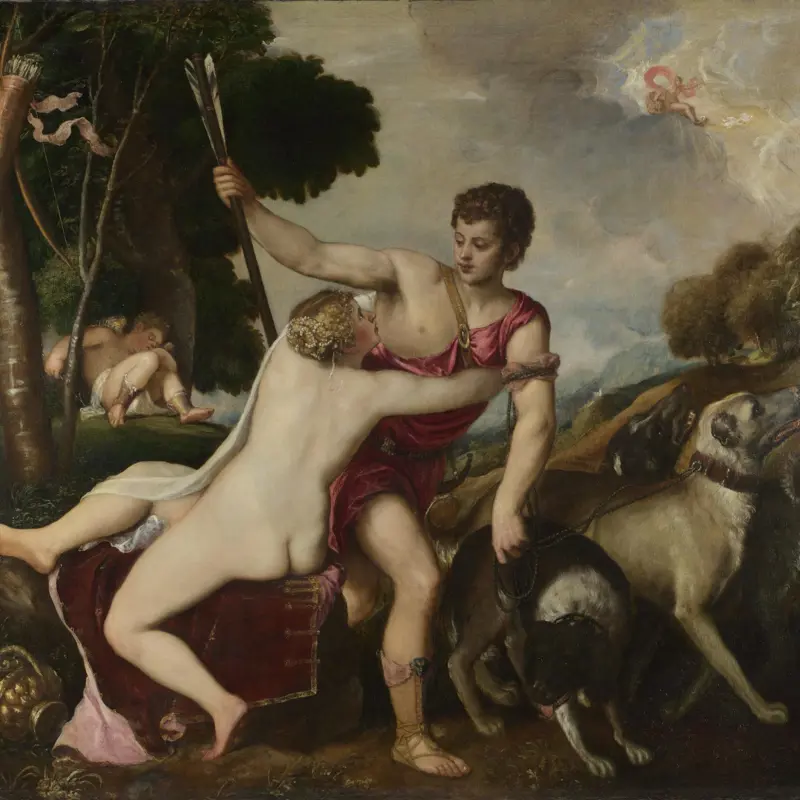Titian, 'Portrait of Gerolamo (?) Barbarigo', about 1510
About the work
Overview
In this, one of Titian’s earliest portraits, the sitter turns to look at us over his shoulder and momentarily meets our gaze. Our attention is focused on the raised brow above his right eye, which is positioned midway across the picture. The man’s elbow rests on a parapet and his voluminous quilted sleeve projects into our space, creating a strong sense of his physical presence. The way in which the shadowed portions of the figure merge with the grey atmospheric background was particularly innovative. This novel and effective pose was to become highly influential in European portraiture, perhaps most famously serving as a model for Rembrandt’s Self Portrait at the Age of 34, now also in the National Gallery.
This was long believed to be a portrait of the celebrated Italian poet Ludovico Ariosto (1474–1533), and then later thought to be a self portrait by Titian. However, the man is likely to be one of Titian’s friends – a member of the aristocratic Barbarigo family.
Key facts
Details
- Full title
- Portrait of Gerolamo (?) Barbarigo
- Artist
- Titian
- Artist dates
- active about 1506; died 1576
- Date made
- about 1510
- Medium and support
- oil on canvas
- Dimensions
- 81.2 × 66.3 cm
- Inscription summary
- Signed
- Acquisition credit
- Bought, 1904
- Inventory number
- NG1944
- Location
- Room 15
- Collection
- Main Collection
- Frame
- 17th-century French Frame
Provenance
Additional information
Text extracted from the ‘Provenance’ section of the catalogue entry in Cecil Gould, ‘National Gallery Catalogues: The Sixteenth Century Italian Schools’, London 1987; for further information, see the full catalogue entry.
Exhibition history
-
2012Titian's First Masterpiece: The Flight Into EgyptThe National Gallery (London)4 April 2012 - 19 August 2012
-
2016Painters' Paintings: From Freud to Van DyckThe National Gallery (London)23 June 2016 - 4 September 2016
Bibliography
-
1854G.F. Waagen, Treasures of Art in Great Britain: Being and Account of the Chief Collections of Paintings, Drawings, Sculptures, Illuminated Mss. […], vol. 2, trans. E. Eastlake, London 1854
-
1877J.A. Crowe and G.B. Cavalcaselle, Titian: His Life and Times, London 1877
-
1895J.P. Richter, 'The Winter Exhibitions of Works by the Old Masters', Art Journal, 1895, pp. 89-90
-
1903O. Fischel, Tizian: Des Meisters Gemälde, Berlin 1903
-
1904R. Fry, 'Titian's "Ariosto"', The Burlington Magazine, VI/20, 1904, pp. 136-8
-
1904A. Solerti, 'Il ritratto dell'Ariosto di Tiziano', Emporium, XX, 1904, pp. 465-76
-
1905A.G.B. Russell, 'Letter in Reply to Roger Fry's 1904 Article: Titian's "Ariosto"', The Burlington Magazine, VI/23, 1905, pp. 412-3
-
1907H.F. Cook, Giorgione, London 1907
-
1926L. Justi, Giorgione, 2nd edn, 2 vols, Berlin 1926
-
1926H.F. Cook, 'Dr Justi on Giorgione', The Burlington Magazine, XLVIII/279, 1926, pp. 311-2
-
1933W. Suida, Tiziano: 304 tavole in fototipia, Rome 1933
-
1934R.N.D. Wilson, The National and Tate Galleries, London 1934
-
1934G.M. Richter, 'Unfinished Pictures by Giorgione', Art Bulletin, XVI/3, 1934, pp. 272-90
-
1935W. Suida, Le Titien, Paris 1935
-
1937G.M. Richter, Giorgio da Castelfranco, Called Giorgione, Chicago 1937
-
1957B. Berenson, Italian Pictures of the Renaissance: A List of the Principal Artists and Their Works, with an Index of Places: Venetian School, 2 vols, London 1957
-
1959Gould, Cecil, National Gallery Catalogues: The Sixteenth Century Venetian School, London 1959
-
1960F. Valcanover, Tutta la pittura di Tiziano, Milan 1960
-
1966J. Pope-Hennessy, The Portrait in the Renaissance, New York 1966
-
1969R. Pallucchini, Tiziano, Florence 1969
-
1969F. Valcanover, L'opera completa di Tiziano, Milan 1969
-
1969H.E. Wethey, The Paintings of Titian: The Religious Paintings, 3 vols, London 1969
-
1971T. Pignatti, 'Über die Beziehungen zwischen Dürer und dem jungen Tizian', Anzeiger des Germanischen Nationalmuseums, 1971, pp. 61-9
-
1975C. Gould, Delaroche and Gautier: Gautier's Views on the 'Execution of Lady Jane Grey' and on other Compositions by Delaroche, London 1975
-
1977J. Steer, 'Mr Bacon's Titian: The Selwyn Brinton Lecture', Royal Society of Arts Journal, CXXV/5254, 1977
-
1980C. Hope, Titian, London 1980
-
1980C. Brown, Titian: Portrait of a Man and Rembrandt: Self-Portrait at the Age of 34 (exh. cat. The National Gallery, 8 October - 7 December 1980), London 1980
-
1987Gould, Cecil, National Gallery Catalogues: The Sixteenth Century Italian Schools, London 1987
-
1988D.R. Smith, '"I Janus": Privacy and the Gentlemanly Ideal in Rembrandt's Portraits of Jan Six', Art History, XI/1, 1988, pp. 42-63
-
1990L. Campbell, Renaissance Portraits: European Portrait-Painting in the 14th, 15th and 16th Centuries, New Haven 1990
-
1990S. Biadene and M. Yakushs, Titian: Prince of Painters (exh. cat. Palazzo Ducale (Venice), 2 June - 7 October 1990; National Gallery of Art, Washington, 28 October 1990 - 27 January 1991), Venice 1990
-
1992J. Shearman, Only Connect: Art and the Spectator in the Italian Renaissance, Princeton 1992
-
1994F. Haskell, 'The Dispersal and Conservation of Art-Historical Property', in J. House, History of Italian Art, Cambridge 1994, vol. 1, pp. 214-69
-
1996P. Mitchell, Frameworks: Form, Function and Ornament in European Portrait Frames, London 1996
-
1997N. Penny, Frames, London 1997
-
2000H. Berger, Fictions of the Pose: Rembrandt Against the Italian Renaissance, Stanford 2000
-
2000J. Cranston, The Poetics of Portraiture in the Italian Renaissance, Cambridge 2000
-
2001
C. Baker and T. Henry, The National Gallery: Complete Illustrated Catalogue, London 2001
-
2001P. Joannides, Titian to 1518: The Assumption of Genius, New Haven 2001
-
2001F. Pedrocco, Titian: The Complete Paintings, London 2001
-
2001G. Fiorenza, 'Pandolfo Collenuccio's "Specchio d'Esopo" and the Portrait of the Courtier', I Tatti Studies, IX, 2001, pp. 63-87
-
2003D. Jaffé (ed.), Titian, London 2003
-
2003J. Dunkerton and M. Spring, 'The Technique and Materials of Titian's Early Paintings in the National Gallery, London', Restoration, III/1, 2003, pp. 9-22
-
2003C. Hope et al., Titian (exh. cat. The National Gallery, 19 February - 18 May 2003; Museo Nacional del Prado, 10 June - 7 September 2003), London 2003
-
2005A. Bayer, 'North of the Apennines: Sixteenth-Century Italian Paintings in Venice and the Veneto: The Triumvirate: Titian, Veronese, and Tintoretto', Metropolitan Museum of Art Bulletin, LXIII/1, 2005, pp. 6-35
-
2005A. Gentili, 'Il gesto, l'abito, il monaco', Studi tizianeschi, III, 2005, pp. 46-56
-
2008L. Silver, 'Image is Everything: Visual Art as Self-Advertising (Europe and America)', in J.K. Nelson and R.J. Zeckhausers (eds), The Patron's Payoff: Conspicuous Commissions in Italian Renaissance Art, Princeton 2008, pp. 185-224
About this record
If you know more about this work or have spotted an error, please contact us. Please note that exhibition histories are listed from 2009 onwards. Bibliographies may not be complete; more comprehensive information is available in the National Gallery Library.

